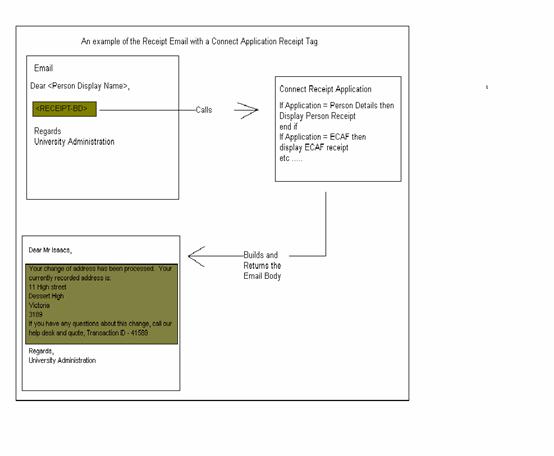
| Top of COR | Index | Table of Contents | Feedback |  |
CORF2660 - Maintain Email Type
| Purpose |
This form will allow the institution to create Email Types and define their content |
|
| SubSystem | Correspondence | |
| Normally Run By | Admission/Assessment Specialist or Connect Transaction Management Administrator | |
| Anticipated Frequency | As required | |
| Structure | Blocks | Email Type |
| Email Substitution Tag | ||
| Button | Edit | |
| This function will allow the institution to create Email Types and define their content. The function will allow the creation of an institution-defined email type. For each email type, the following information will be defined:
When adding institution-defined tags, remember not to make the tag like normal text as blocks of text could be replaced that you don't want replaced. Instead, consider unique tags not found in normal text. For example, ##PROMPT-ST## as a beginning tag is unique and would never be seen in normal text. This form is accessed from the main menu. |
The Email Account block contains:
The Email Substitution Tag block contains:
|
Rules/Notes: The Edit Button This form utilise the webutil feature. The ’Edit’ button opens the content column in a default editor (Notepad). This allows the user to edit and save data exceeding 32000 characters outside the form. The results can be saved back to the database. Validations include:
It is possible to use an institution defined substitution variable that maps to the same system substitution variable as another institution defined variable. See an example of a diagram of the Receipt Email with a Connect Application Receipt Tag below The last validation means one institution defined mapped variable at a time in a document. When an email type has multiple institution substitution tags that map to a single system tag the above validation will fire. A Receipt BODY Tag. When the function that issues the email encounters the RECEIPT-BD tag (<REC-BD>), it will go to the Connect Receipt Application and collect the applicable part of the receipt template, then format the body of the email from the receipt template. See Receipt Application for more details. The Connect Transaction Application and the Self-Serve Application Transaction Log Substitution Tags, PROMPT, OLD (Value) and NEW (Value) have both a start and end tag:
Using the start and end tags allow the Administrator to include within the email definition a call to a Connect Receipt Application with effect of the tag being substituted by the Connect Application. For example, using the start tag #PROMPT-ST#; the end tag #PROMPT-END# and a parameter sequence for a specific prompt of 3 would look like:
|
Example of the Receipt Email with a Connect Application Receipt Tag

Email Substitution Tag
An email type can be built using an email substitution tag. When an email type contains an email substitution tag, then the tag is replaced with the database value that it represents.
Transaction Management
Email types may be used to issue a email receipt to a student using Connect. The email type (the email receipt) can be defined with detail tags to create an email receipt for each Connect application that is being used for transaction management.
Alternatively, an administrator can use an institution tag mapped to the system <REC-BD> tag which will result in Connect Receipt Application and Receipt template being used to create the email receipt.
Field Details
| Label | Field Source | Field Type | Format | Comments |
Email Type: |
EMAIL_TYPE.EMAIL_TYPE |
Text |
VARCHAR2 (10) |
. |
Closed |
EMAIL_TYPE.CLOSED_IND |
Check box |
VARCHAR2 (1) |
. |
Reply To Address: |
EMAIL_TYPE.REPLY_TO |
Text |
VARCHAR2 (100) |
. |
Description: |
EMAIL_TYPE.DESCRIPTION |
Text |
VARCHAR2 (60) |
. |
Subject: |
EMAIL_TYPE.SUBJECT |
Text |
VARCHAR2 (500) |
. |
Message Content Type: |
EMAIL_TYPE.S_MESSAGE_CONTENT_TYPE |
Text (with LOV) |
VARCHAR2 (10) |
. |
N/A |
S_MESSAGE_CONTENT_TYPE.DESCRIPTION |
Display Field |
VARCHAR2 (60) |
Not Updateable. Message Content Type Description |
Body: |
EMAIL_TYPE.CONTENT |
Text |
CLOB |
. |
| File Name: | N/A | Display Field | VARCHAR2(255) | This field is populated when the edit button is used to save a file to the file system. It is not directly editable. |
Substitution Tag |
EMAIL_TYPE_SUBSTITUTION_TAG.EMAIL_SUBSTITUTION_TAG |
Text (with LOV) |
VARCHAR2 (10) |
. |
Description |
EMAIL_SUBSTITUTION_TAG.DESCRIPTION |
Display Field |
VARCHAR2 (60) |
Not Updateable |
Last Modified on 30 May, 2012 8:13 AM
History Information
| Release Information | Project | Change to Document |
| 12.0.0.3 | 1408 - Calipso | Removed validation - Cannot use an institution defined substitution variable that maps to the same system substitution variable as another institution defined variable |
| 10.0.0.0.0.0 | 1225 - Connect Transaction Management | Added Email Subscription Tag and Applicant Portal paragraph in Introduction. Added new validations, diagram and following Notes |
| 9.1.0.0.0.0 | 1221 - eAdmissions - Applicant Portal 2 | New form |